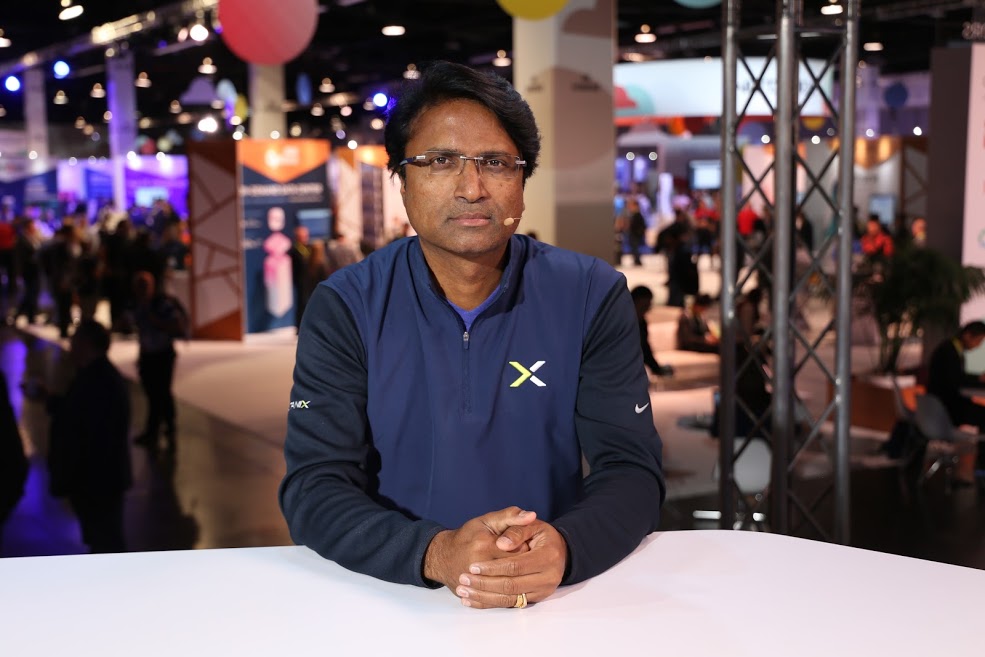 INFRA
INFRA
 INFRA
INFRA
 INFRA
INFRA
When admiring another’s garden, it’s easy to forego tending one’s own flowers. In the fast-paced world of software updates, operations can get weedy for even the biggest cloud computing service providers, as they take care of customer needs while striving to ensure their core values and individuality don’t get lost in the yard.
Such is the case for Nutanix Inc., the software-defined storage provider, balancing many obligations to both partners and customers. The company straddles the two worlds of hardware and software, working to maintain agile operations and strategic relationships by studying past mistakes.
Sunil Potti (pictured), chief product and development officer at Nutanix, spoke with Rebecca Knight (@knightrm) and John Furrier (@furrier), hosts of theCUBE, SiliconANGLE Media’s mobile livestreaming studio, during the .NEXT event in Anaheim, California. They discussed the company’s shift from hardware to software, how it’s utilizing cloud technology to better serve customers and partners, and how Nutanix is maintaining its culture (see the full interview with transcript here). (* Disclosure below.)
[Editor’s note: The following answers have been condensed for clarity.]
Furrier: As you guys are shifting from being hardware to software, things start to be different. As you start thinking about the convergence of clouds, you’re doing [hyperconverged infrastructure] for the cloud. Explain that concept.
Potti: Some of this, obviously, we are struggling through, but we are not afraid of making mistakes in this transition as you’ve seen over the last year. We’ve gone from being a plans company, to a software that runs on a third party … to now running on clouds. All that within a span of 12 months while building a business. Sometimes it works. Sometimes we pick ourselves up and learn from our mistakes, but to your point, I think, we’re not afraid to become an app on somebody else’s operating system. Just like Microsoft said, “Look, we’re going to release Office on Mac or iPad before we even do it on Windows.” That kind of thinking must permeate, and pretty much every technology will end up going forward.
If somebody wants to consume their applications that they built on Nutanix on-premise, but their idea was that they don’t want to be in the data center business tomorrow without changing the apps, they should be able to take that entire infrastructure and their applications and consume inside Amazon’s fabric because they provide a bunch of other services as well as data centers. A recent announcement of Nutanix in AWS, not on AWS, is an example of us becoming an app on somebody else’s operating system. That’s an example of us transforming further away from being an infrastructure-only or an appliance-only company.
Furrier: What does this mean for your customers and your partners?
Potti: We always used to think about ourselves as a smart phone for the enterprise … but we had to prove that model by owning the full stack like Apple did. But over time, democratization happens by distribution. So, in some ways, we must become more of an Android-like company while retaining the best practices of the delight and the security of an Apple device. So, that’s the easiest analogy here.
We’re trying to work with partners like Dell, Lenovo, and now, increasingly, Hitachi, Fujitsu, Inspur and Intel. Everybody is signed up because everybody knows that the customers want this experience, and now the latest relationship with HP takes it to the next level. We want to bring super micro-like appliance goodness, one-click upgrades, support, everything, but with an HPE-backed platform that both companies can benefit from.
Knight: How would you describe the Nutanix culture, and how do you maintain the culture?
Potti: I’ll tell you the journey that I was on, that there were a couple of things that I brought to the table, a couple things that I learned myself, as well as what I could see, a couple things that you’ll see in a company that has been built by founders. I’m not a founder or entrepreneur myself, but I’ve seen them in action now. They bring one dimension that I’ve not seen in big company leaders, which is continuous learning. That’s the only way they can stay in the company when it goes from zero to 90. The folks that continuously learn are the ones that stay. If they don’t, they leave, and we get professional leaders.
Continuous learning, if it can be applied to the generic company, becomes an amplifying effect. People can learn how to grow, they look around the corners, they can learn things that they aren’t born with. So, I think that’s one unique dimension that Nutanix inculcates in a lot of people.
The other dimension, which I think everyone knows about Nutanix, is being humble, hungry, honest and with heart. Those four words sort of capture a sense of playful authenticity, but I think we’re not afraid to be wrong, and we’re not afraid to make fun of ourselves. We’re not afraid to be ourselves. That, I think, is easy to say but very hard to do.
Watch the complete video interview below, and be sure to check out more of SiliconANGLE’s and theCUBE’s coverage of the .NEXT 2019 event. (* Disclosure: TheCUBE is a paid media partner for the .NEXT conference. Neither Nutanix Inc., the sponsor for theCUBE’s event coverage, nor other sponsors have editorial control over content on theCUBE or SiliconANGLE.)
Support our mission to keep content open and free by engaging with theCUBE community. Join theCUBE’s Alumni Trust Network, where technology leaders connect, share intelligence and create opportunities.
Founded by tech visionaries John Furrier and Dave Vellante, SiliconANGLE Media has built a dynamic ecosystem of industry-leading digital media brands that reach 15+ million elite tech professionals. Our new proprietary theCUBE AI Video Cloud is breaking ground in audience interaction, leveraging theCUBEai.com neural network to help technology companies make data-driven decisions and stay at the forefront of industry conversations.